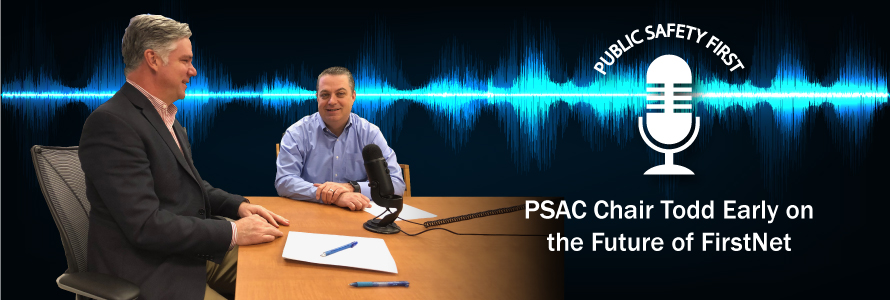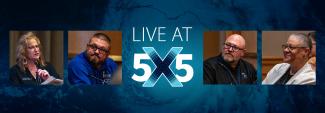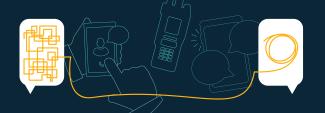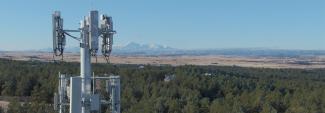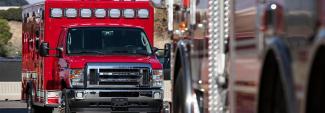Summary
In this episode, Public Safety Advisory Committee (PSAC) Chair Todd Early shares his thoughts on the future of the network and the critical role public safety will play in shaping the FirstNet Authority’s Roadmap for advancing the network.
Guest
Dave Buchanan
FirstNet Authority Director of Public Safety Advocacy
Todd Early
Assistant Chief, Infrastructure Operations Division, Texas Department of Public Safety
Transcript
Preview
Narrator: You're listening to Public Safety First, a podcast to help you learn about the First Responder Network Authority and how you can be part of the future of public safety technology. And now, your host, Dave Buchanan.
Narrator: You're listening to Public Safety First, a podcast to help you learn about the First Responder Network Authority and how you can be part of the future of public safety technology. And now, your host, Dave Buchanan.
Dave Buchanan: Welcome to the Public Safety First podcast. Today we’re in the Reston, VA headquarters of FirstNet where I’m joined by Todd Early. Todd is known to many of you – and has been a fixture in the public communications community for many years. He serves as the Assistant Chief of the Infrastructure Operations Division of Texas Department of Public Safety [DPS]. We’ve known Todd through FirstNet for many years. He’s been the Chair of our Public Safety Advisory Committee [PSAC] since last November. He’s been appointed for the last five years by his governor as the Single Point of Contact for Texas. He’s a Statewide Interoperability Coordinator for the state of Texas. He joined our PSAC back in 2015, representing NCSWIC [National Council of Statewide Interoperability Coordinators]. And he also served as our Tribal Working Group Liaison and led our Early Builders Working Group. Welcome to the podcast, Todd.
Todd Early: Thanks, Dave. Glad to be here.
Dave Buchanan: So the PSAC’s role is to help us guide and advise the FirstNet Authority on the deployment of the network. Everyone’s well familiar with the role the PSAC played leading up to governors’ decision. We talked about this, Todd, in a previous episode, and we were fortunate to have Harlin McEwin on an episode in December where we talked about that role. Now we’ve moved into, as we talked about a little bit on a previous episode, into the operational phase of FirstNet. Todd, talk a little bit about how this has changed the work of the PSAC and what you’re most excited about — about those contributions those PSAC members can provide us, again as we think about how to operationalize FirstNet in public safety agencies.
Todd Early: You know, Dave, the involvement of the PSAC and the partnership that the PSAC has with the FirstNet Authority leadership, with the FirstNet Board – our PSAC has a lot of subject matter experts on the membership of the PSAC from many of the national organizations of first responders. That ability that they have to bring that knowledge, that expertise, and the ability to identify the things that are needed really are going to coincide and advise FirstNet on the strategy, the roadmap, what gaps public safety’s facing today, and how the deployment and operationalization of FirstNet can really, you know, help solve some of the gaps that are out there in public safety.
Dave Buchanan: So, at the most recent March Board meeting of the FirstNet Board, we talked a lot about the roadmap, we talked a lot about investment. I talked during my briefing about our plans to engage public safety to populate the roadmap with public safety’s needs so we could use that roadmap to make future investments, enhancements and improvements to the network. So, really it’s our job at the Authority for the next 23 years in this 25-year contract – our commitment to public safety to get their inputs, to use those inputs to make a roadmap, and use that roadmap to make investments in the network. The PSAC’s going to be central to our work in populating that public safety roadmap. Can you talk a little bit about that opportunity that you see, and how we’re going to work together to achieve that starting this year?
Todd Early: Absolutely. It’s really exciting to us to be able to have involvement and discussions into, into that roadmap, into that strategy. You know, this network, as branded by FirstNet for many years has been ‘built for public safety, by public safety’ and the ability for first responders to, for the first time ever, have input into a network, have input into what they need as far as the technology, as solutions, to really solve the problems that they have in their everyday response and in their disaster response, I think is really important and I think it’s really changing the tools and technology that’s going to be put in the hands of first responders for many, many decades to come. To have that, that ability to identify the gaps, the areas of reinvestment that needs to be put towards technology towards the other things, to solve these gaps, I think is really important. I think that really strengthens the relationship between the PSAC and the partnership, between the PSAC and the FirstNet Authority, and the Board.
Dave Buchanan: You and I worked together before there was a FirstNet, on the consultation process. And I like to describe the way we’re going to go about engaging public safety in 2019 isn’t altogether different than the way we engage public safety to get inputs to build the RFP, to get inputs to build the state plan. Now, our work together and the work with the FirstNet Authority is going to do across the country is to get those – use those same kind of engagements – to get those kinds of inputs, so now we can make future investments and future enhancements in the network. To me, that’s really exciting. We’ll be able to continue our promise to public safety and to continue to make sure we’re at the cutting edge of bringing them exactly what they need so that they can do their jobs. We talk a lot about public safety operations when we talk about what the public safety community needs and what kind of operational gaps we might be able to fill. And Todd, you and I have talked about the various disciplines and communities we have, whether it’s our fire professionals, and the fire professionals that work in the PSAC, or law enforcement, or the emergency communicators, or emergency managers. Can you talk a little bit about how we’re going to focus our work around those disciplines to extract even better operational needs for the network?
Todd Early: Absolutely. As I was saying earlier, you know, we have a lot of expertise on the PSAC and much of that expertise is really centric around disciplines that are first responders. And so to have the ability to reach out to our PSAC Executive Committee and the other members of the PSAC and to really draw upon their expertise within those various disciplines, I think, is going to allow us to identify and really gather the information that we need to focus on the reinvestments, on the strategy, on the solutions, on the technology to be able to really ensure that this network is benefitting public safety. You know, what works in some parts of the country, the requirements may be different in other parts of the country. What’s needed in rural areas, you know, may not be needed in metro areas. And I think the ability to identify all of those needs and to really focus those around the roadmap and around the strategy and around the reinvestment, I think is really going to be beneficial to public safety.
Dave Buchanan: So in June we’re going to have an in-person PSAC meeting. We’re going to use that as an opportunity to really, again, populate and validate the roadmap that the FirstNet Authority expects to produce later this summer. And so I’m really looking forward to that meeting and again, I think this is going to be a terrific opportunity for us as we make sure we’re getting the right kind of input in this very first roadmap, to be able to use the PSAC that way. So, we’re looking forward to that.
As I mentioned at the top of the podcast, you wear more than one hat. You’ve got a busy life and a busy job. I want to now pivot to your work inside of Texas. You’re one of the early subscribers to FirstNet. Can you talk a little bit about what your work entails inside of Texas from a public safety standpoint?
Todd Early: Absolutely. My daily job is the Assistant Chief of the Infrastructure Operations Division, but I’m ultimately responsible for the statewide public safety communications of the Department of Public Safety of the State Police. And then also serve as the Statewide Interoperability Coordinator and working with local and state public safety entities to talk about interoperability and the needs of public safety, and that has really transitioned into the early involvement as the Early Builders, partnership with Harris County, and then over on to the work with FirstNet and being involved in the PSAC, and now the Chair of the PSAC. You know one of the things that I call a blessing is getting to work with public safety to identify those needs, to talk about how we benefit public safety, to really have the ability to have the involvement into something like this is not only a blessing, but it’s really rewarding knowing that we are really getting to do something that’s really going to benefit public safety and every citizen of the state and the U.S.
Dave Buchanan: And how long have you worked for the state of Texas?
Todd Early: A little over 25 years.
Dave Buchanan: And so you’ve seen a lot of change in public safety communications in the last 25 years. Talk a little bit about the change you made in the last, how many years has it been? Since you made the pivot from – since you adopted broadband?
Todd Early: So back in 2011 is when we really started.
Dave Buchanan: So you’ve obviously seen a lot of change in public safety communications in Texas. You’ve made the evolution from LMR [Land Mobile Radio] to now utilizing broadband – talk about what that has been like for your agency and what that change has – what kind of improvements that change has brought you.
Todd Early: You know, I’ll go back to some of the changes in just the personal technology that we all use. You know, we all rely on daily. And then you transition that into our public safety environment – having the ability to take those tools and technologies and applications, and you know, they really become a force multiplier in public safety, when you think about it. But what we didn’t have was a network that public safety could depend on during times of disaster, and in the need. And so having a network that we can prioritize our public safety first responders on – knowing that when they get into these situations, into these disasters, into these emergency responses, they’re going to have a network that’s dependable and that they can count on, I think is extremely important. So, to be able to watch and be involved in that evolution, you know, is really amazing, and is really something that I think we’re going to see benefit first responders for many years.
Dave Buchanan: What’s the user experience like for first responders at Texas DPS? What kind of devices are they using? What do you think is the most popular software or applications they’re using to do their jobs?
Todd Early: You know, we’ve transitioned, as soon as we were able to, we transitioned where we had coverage over to the FirstNet service, and have utilized that during several responses and emergency responses and disasters and tragedies, as well as in our everyday operations and response. And really it’s been knowing that we have a network that prioritize when they go into these actual disasters and responses. Having that ability to have that network, but also having the ability to have the mobile response units that are able to deploy out, you know, with us to go out there and either provide coverage, enhance coverage, and really, you know, stage with us during these times is extremely important and really been beneficial to knowing and ensuring that we have what’s needed to provide that response. I’ll also say, Dave, that we’ve utilized some of the emergency mobile response on wildfires and floods and being able to make a phone call and have the response equipment, the support that’s necessary, even if it’s just staging, has been really beneficial to us and that we’ve really never had before, strictly to public safety.
Dave Buchanan: So one of our responsibilities at the Authority is to work with public safety, to really understand that user experience so that we can capture best practices and use cases to share broadly across the country on how first responders are effectively adopting and operationalizing FirstNet. But we’re also here to make sure we understand what are some of the challenges and opportunities that public safety is experiencing or wants to see in the network. Talk a little bit about what you see as opportunities for us, or challenges that you’re facing when you think about FirstNet. We are only two years into this. We still have a ways to go. As I mentioned, our commitment is to continue to work with public safety to help make sure we’re enhancing and improving the network for your use. What do you see as the most pressing either challenges or opportunities?
Todd Early: You know, one of the things that I think that we see and hear is, now that we have an operational network, now that people are using it, and public safety is really seeing the use cases and how it’s being utilized, what I hear is people want it now. And it takes time to build this kind of network out. The state plans were a 5-year plan. Building out that coverage and capacity in areas takes a little bit of time, and so that’s a good thing that people want to utilize it and want to have that ability. I think the thing that really resonates with public safety and the thing that excites me about leading the PSAC and having this involvement is, there is a strategy now. There’s a roadmap. The reinvestment is going to really look towards that roadmap and that strategy. And I think public safety, to be able to have input into that, I think goes a long way with public safety and it really provides public safety with the comfort of knowing that the thoughts and processes and strategies that are put together really focus on what public safety needs. And I think that’s really important and it’s something that again, we’ve never had before when it comes to this type of network and tools and technology in public safety.
Dave Buchanan: So you’ve got an interesting vantage point in Texas in your role. We’ve talked about how unique Texas can be. You’ve got some of the largest cities in the country, you’ve got western counties that only have populations in the hundreds. You’ve got the border, you’ve got tornadoes, you’ve got hurricanes. How would you describe the different way that those different population sets and those different first responders are thinking about FirstNet. Is there any trends about the way they’re looking at FirstNet, as they’re thinking about FirstNet two years into this that you can share?
Todd Early: You know, I think it’s, as I said earlier, I think the different needs are different in parts of the state, whether its rural, or urban, or the various disciplines. I think, as we transition through this network and what it provides, I think folks are now getting to experience a network, if they have coverage, that has priority and preemption, now we’re having more devices that are available on the network. And I think you just see a trend of the advancement of the tools and technology now that we’re starting to get into applications. You know, having discussions with public safety, which I know the PSA team is doing with the Public Safety Advisory Committee, but also doing with all the disciplines across the state. And I think engaging those disciplines, having the discussions on what really benefits them, what do they need. I think we’re going to continue to see advancement in technology, advancements in the use cases, and how they’re really used in public safety.
Dave Buchanan: So, one of the high profile and highly visible ways that the public sees and public safety sees the use of the network is in a time of a disaster. And, I know you’ve had some experiences using the network, most recently with the floods in Texas. Can you talk a little bit about what that was like for you and for public safety?
Todd Early: Absolutely. When you start looking at these types of tragedies, you have to really think about what’s needed, not for the immediate, but for the future of the disaster. And again, having deployables available to public safety, being able to stage those deployables in the areas that were able to work with the weather service and other folks is really important. And making sure that, really when you look at it, today the majority of society counts on wireless devices as their primary phone. When you get in times of disasters, you have to have a network that they can rely on to call for safety, to call for help, but that also our first responders can rely on. I think having the ability to have the deployables, having the ability to know that when your responders go into those areas they have priority service, they have preemption, it really has advanced the response capabilities that we give our first responders, not only in Texas, but everywhere.
Dave Buchanan: What was that experience like for you: requesting deployables, having the deployables delivered, the performance of the deployables, what was that like?
Todd Early: Well, you know, I’ll tell you, knowing that you have a set amount within a state and also surrounding the state, to have that capability is really important. When you go into these types of disasters, you’re extremely busy. And to have the ability to make one phone call, get the information to them, and then be provided updates, has really been beneficial. And quite honestly, the response times, they’ve really worked with us to make sure that they get on the road as quickly as they can. They’re there to help us until we don’t need them anymore. The feedback that we’ve received from our first responders in some of these, whether it’s been the wildfires where they didn’t have coverage and that part of the coverage in the buildout hasn’t made it to that location yet, the feedback’s been really positive.
Dave Buchanan: So, as we’ve done early engagements with public safety around the roadmap and gotten early feedback and done early prioritization engagements and surveys, we’ve really narrowed the focus of the roadmap around five operational topics that we want to focus on in 2019: coverage and capacity, situational awareness, user experience, voice communication, data management, are the five lanes that we’re going to be working on primarily as we think about how to focus the public safety conversations around the roadmap. Which one of those, Todd, do you – sticks out as a priority for you or is one you believe we should be spending some time on this year?
Todd Early: You know, Dave, as I look at all five of those, they’re all five extremely important. Two or three really stick out, and obviously coverage – everybody needs and wants coverage in areas that they don’t have it and that’s extremely important in getting the network to them that they need. So, coverage is always important, we have the state buildout plans, we know what’s going to be done in that piece of it. But, as we seek input back from first responders, even identifying areas of coverage that may not be identified in state plans, is extremely important. Situational awareness is very important to us. Knowing where our responders are at, having the ability to get help to them when that help is needed. We have situational awareness in the majority of what we do. I think what really is going to be beneficial to public safety is, and this is probably part of data management and interoperability, but having the ability to see multiple disciplines in areas where you have first responders coming from many organizations and having that ability to have that situational awareness is extremely important. Obviously, z-access is extremely important when it comes to first responders. Having the advancement on that, I think, is really important, as well. The other thing I’ll say too is, user experience. You know, now that we have an operational network, I think it’s really important, and I know you all are doing a, you know, making a large effort to do that, and we want to do the same thing in the PSAC is – we want to gather the user experience, we want to know the use cases, what works, what doesn’t work, what can we focus on in the future to really enhance that user experience to meet the needs of that agency and the discipline and response that they provide.
Dave Buchanan: Well, I want to thank you, Todd, for joining the podcast today. We really appreciate your leadership in the state of Texas, we appreciate your leadership on the PSAC. And we’re grateful that you’ve joined us here today and I’m grateful for the time we’re spending together to plan for our 2019 activities.
Todd Early: Thanks, Dave, I appreciate it. It’s an honor to get to work alongside the members of the PSAC and to get to be the chair of the PSAC. I don’t take that lightly, and I look forward to working with the FirstNet Authority and all the members of the PSAC and public safety to provide the input that’s needed. And, I appreciate being able to be here for a couple days of planning. Thank you.
Narrator: Thanks for listening today. We're excited to have you join our podcast community. Make sure to subscribe on iTunes, SoundCloud, and YouTube. You can learn more about the First Responder Network Authority at FirstNet.gov and learn about FirstNet products and services at FirstNet.com.


